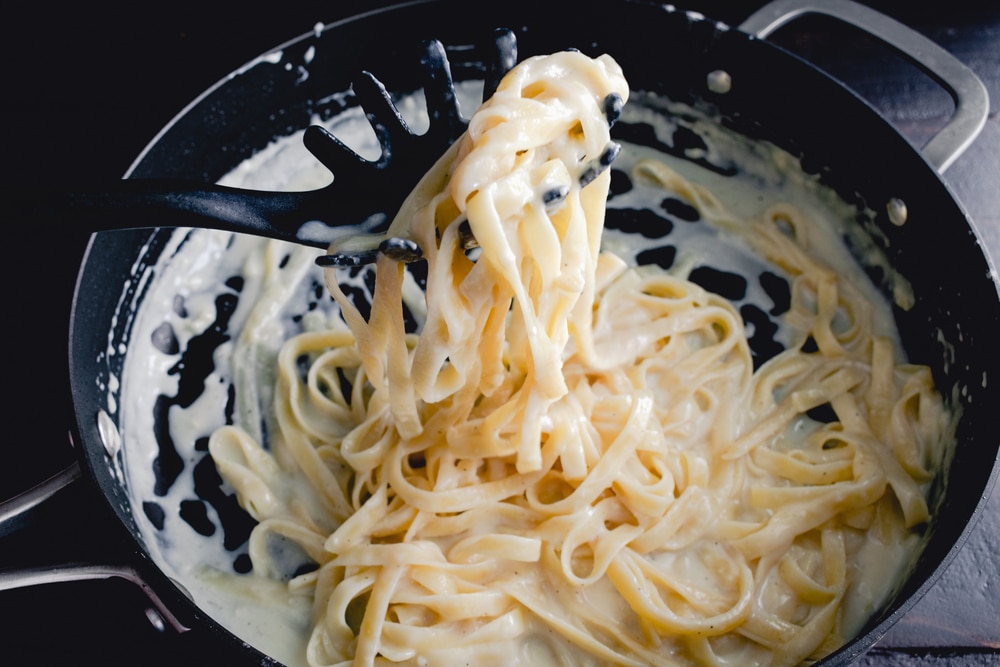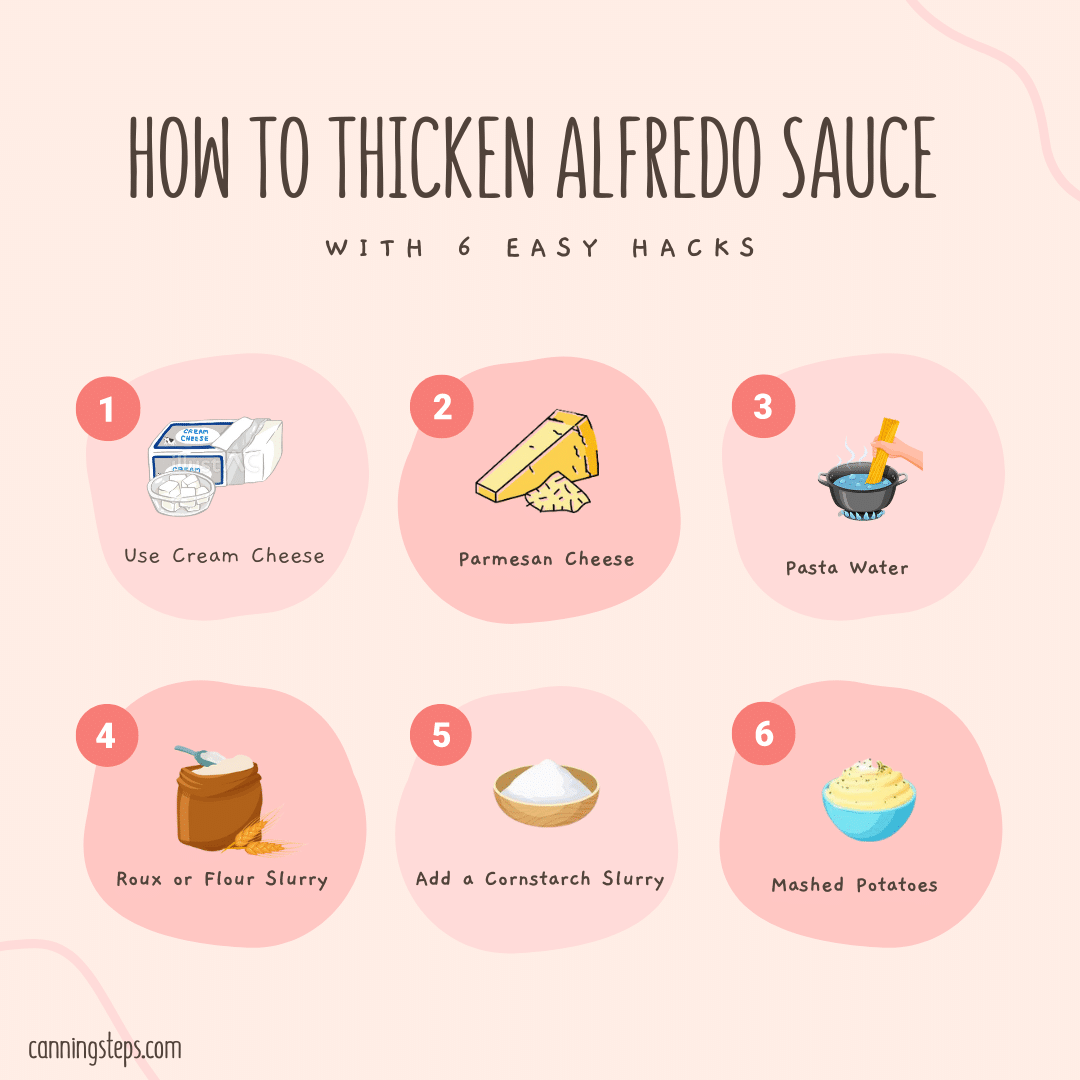Craving for a rich, creamy Alfredo sauce that clings perfectly to every bite of pasta? But what if the sauce gets runny and thinner than desired during preparation? Keep dreaming of a perfect plate of pasta, and don’t worry! Thickening Alfredo is easier than you think. You can savor your delicious pasta with the desired sauce consistency with just a few simple tricks and can transform a runny sauce into a velvety, indulgent masterpiece. Whether you’re preparing a classic fettuccine or experimenting with other dishes, these tips will help you achieve a luscious, creamy sauce. Let’s dive into the best techniques to thicken your alfredo without sacrificing flavor and texture.
Why Your Alfredo Sauce Might Be Thin

Before diving into the solutions, it’s important to understand why your alfredo sauce get thin at first place and what mistakes are made during its preparation that result in thinner consistency than desired.
- The main culprits are incorrect proportions of liquids and fats.
- Secondly, cooking it too quickly on the stovetop.
- Not using enough thickeners like cheese or egg yolks.
- Additionally, if you’ve used regular milk instead of heavy cream or heavy whipping cream, the consistency might be thinner than you’d like.
How to Thicken Alfredo Sauce

1. Use Cream Cheese for Thickness
One of the easiest ways to thicken an alfredo sauce without heavy cream is to add cream cheese. This ingredient provides a rich, smooth texture and helps bind the other components of the sauce. To incorporate it properly, make sure the cream cheese is at room temperature, and then melt it into the sauce over low heat on the stove top. Stir constantly to prevent lumps, and you’ll notice your sauce becoming thicker and more luscious.
2. Try Egg Yolks for a Velvety Finish
Using egg yolks is another excellent method for those looking for an ultra-creamy texture. This is particularly useful for making an alfredo sauce without heavy cream. The egg yolks act as an emulsifier, helping the sauce to thicken without becoming clumpy. To avoid scrambling the egg yolks, you should temper them by whisking in a small amount of the hot sauce first before slowly incorporating them back into the main pot. Be sure to do this over low heat on the stove top.
3. Save and Use Pasta Water
If your alfredo sauce is too thick, pasta water can help thin it out while maintaining flavor and texture. But did you know that pasta water can also serve as a thickening agent? The starches in the water help the sauce cling to the pasta better. Slowly add some reserved pasta water while stirring the sauce. It will thicken slightly, giving your sauce a perfectly smooth and creamy consistency.
4. Incorporate More Parmesan Cheese
Cheese is a natural thickener, and adding extra parmesan cheese can give your Alfredo sauce more body. Be sure to use freshly grated parmesan cheese for the best results. If you’re looking for a substitute for parmesan, consider using Pecorino Romano, which is saltier and can help thicken the sauce just as well. Grated cheeses like these melt into the sauce and add both flavor and thickness.
5. Use Heavy Whipping Cream or Heavy Cream
Traditional Alfredo recipes often call for heavy whipping cream or heavy cream, and for good reason—they both provide the richness and texture that make Alfredo what it is. If your alfredo sauce is thin, you can always add more heavy whipping cream to the mix and allow it to simmer gently on the stovetop until it reduces and thickens. Avoid boiling the cream, as this may cause it to separate, creating a grainy texture instead of a creamy sauce.
6. Add a Roux or Flour Slurry
For a more structured approach to thickening, a roux (a mixture of flour and fat) or a flour slurry can work wonders. To create a roux, melt butter in a pan and slowly whisk in flour until the mixture is smooth. Then, whisk this into your alfredo sauce. If you’re looking for a sauce without heavy cream, this method works well, as it can thicken even when using regular milk or other lighter dairy products.
A flour slurry, made by mixing equal parts flour and water, can also help thicken without altering the flavor too much. Simply stir it into the sauce while it’s cooking on the stove top and allow it to thicken over a few minutes.
If you are a spaghetti lover than learn canning homemade spaghetti sauce to keep your kitchen well-stocked with jars of mouthwatering sauce, ready to satisfy those sudden cravings anytime.
How to Thicken Alfredo Using Non-Dairy Options

If you’re looking for a sauce recipe without heavy cream or dairy, there are still options to thicken your sauce. Coconut milk can provide creaminess, while cornstarch or arrowroot powder can be used to thicken the sauce. These methods are great for those who are lactose intolerant or want a lighter version of the sauce.
7. Add a Cornstarch Slurry
If you prefer not to use flour, cornstarch is an excellent alternative for thickening Alfredo. To do this, mix one tablespoon of cornstarch with a small amount of cold water to form a slurry. Gradually whisk this into your simmering alfredo sauce on the stove top until it thickens. This works particularly well in recipes for alfredo sauce without heavy cream.
8. Include Mashed Potatoes
For a unique twist, consider using mashed potatoes to thicken your Alfredo Sauce. Here’s how to do it. Cook and mash potatoes until smooth, adding a bit of milk or butter for creaminess. Gradually add a few tablespoons of mashed potatoes into your sauce while stirring. Ensure the potatoes are well incorporated to avoid lumps.
9. Reduce the Sauce by Heating
When it comes to reheating alfredo sauce, the key is to do it gently. Reheating sauce too quickly or at too high a temperature can cause it to separate or become grainy. The best way to reheat Alfredo sauce is on the stovetop over low heat.
If you find that your sauce has thinned out during reheating, don’t panic. You can use some of the thickening methods mentioned earlier, such as adding a little extra parmesan cheese or cream cheese, or stirring in some pasta water.
Common Mistakes to Avoid
Overcooking the Sauce
Cooking the alfredo sauce over high heat can cause the dairy to curdle, leading to a broken sauce. Always simmer on low to medium heat.
Using Low-Quality Cheese
Always opt for freshly grated parmesan cheese or a substitute for parmesan that melts well.
Not Stirring Enough
Constant stirring is essential for keeping the sauce smooth and preventing clumps, especially when using thickening agents like egg yolks or cheese.
Conclusion
Achieving the perfect creamy sauce doesn’t have to be difficult. Worry not if your sauce gets thin or runny; just hold your breath and start using these simple tricks and hacks to get your sauce back to the desired consistency. Whether you’re using heavy whipping cream, cream cheese, or egg yolks, there are numerous ways to thicken your alfredo sauce and ensure it’s rich, velvety, and delicious. Experiment with different techniques to find the one that works best for your sauce recipe without heavy cream, and enjoy a delicious, thick Alfredo every time.




